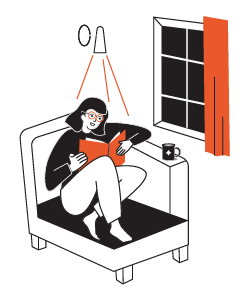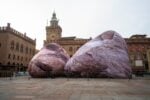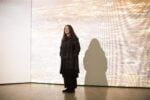Brian O’Doherty / Richard Artschwager

Mostra doppia personale.
Comunicato stampa
The two extraordinary solo exhibitions were chosen to co-inaugurate at settantaventidue because of the unique way both the American artist and the Irish artist interact with the architectural space.
Site specific installations of historical works by Brian O’Doherty and Richard Artschwager will be visible at settanteventidue in dialogue with the gallery’s spaces.
Brian O’Doherty - Retrospective
What kind of art can emerge if you are a bustling, clever and widely received theorist and critic at the same time? Do these practices amalgamate or is it possible to keep them separate? And if so, how? Does the art emerge to test the theory, or does the theory emerge from the art? Although we can no longer ask Brian O’Doherty these questions, we can try to answer them by looking at his artistic oeuvre.
O’Doherty was several things at once: doctor, editor, artist, Irishman, writer, critic, husband, theorist. He saw the challenge of living out manifold roles and reflected upon it. So it was not without reason that he coined four pseudonyms to keep the various fields of work with their different mindsets separate from one another. He left the art criticism in part to Mary Josephson, while Patrick Ireland took over Brian O’Doherty’s artistic practice from 1972 to 2008: the change in name, which took place in a performance of the same title (Name Change) was primarily politically motivated: it was due to the violent events in Northern Ireland, Bloody Sunday. After a period of peace, Patrick Ireland was ceremoniously buried in Dublin. The message here: identity is a construct, but for O’Doherty bound to very personal matters and his Irish homeland.
His drawings, paintings, and sculpture, being conceptual, thus draw from the intellectual discourses in which they emerge.[i] And yet they have a strong link to the biography, to the body of the artist. This becomes most clear in The Body and its Discontents, created in 1964: a kind of miniaturized medicine cabinet, with a total of 60 compartments filled with small boxes that are pasted on all four sides with a paper in different shades of pastel and various specialist medical terms. These refer to male and female body parts, to our sensory capacities, but also to illnesses. As bone dry as the work might seem at first with its scientific vocabulary and rigid system of order, it is also playful and humorous. It makes it possible to create a variety of bodies, including bigendered ones, with various infirmities, an individuality using the components of medicine and conceptual art. O’Doherty transforms the “aesthetics of administration” that Benjamin Buchloh so cleverly attributed to conceptual art into an “aesthetics of anatomy.”
Daniel Buren’s thoughts about the “function of the studio” was published in English in 1979. Here, he describes and criticizes the studio as a site of production, in which works emerge that are intended to be seen somewhere else. Buren characterizes this site as a “predictable cubic space, uniformly lit, neutralized to the extreme,”[ii] or in other words, O’Doherty’s words, as the white cube. Buren as well as O’Doherty/Ireland largely refused a painterly practice that created transportable pieces, O’Doherty/Ireland’s preferred site to paint is on the wall, but the Rope Drawings he began creating in 1973, expressly labelled “drawings,” allow a certain mobility by way of their re-installation. The cords are stretched over colourful surfaces that result in geometric compositions and extend out into the exhibition space; seen from a single place (and with just one eye) in the room, these cords become the outlines of the coloured surfaces. In this way, the three-dimensional, expansive work becomes something flat. This “ideal” standpoint is oriented toward the body size of O’Doherty’s wife, the art historian Barbara Novak.
In this way, personal aspects flow into a conceptual work that explores artistic issues such as the illusory, the inclusion of real space and its reception: in the “The Eye and the Spectator” included in the essay collection “Inside the White Cube”, O’Doherty explains how in light of contemporary sculpture the eye and the spectator separate from one another, since the sculptures demand that we move around them. The Rope Drawings equally demand, to remain in the terminology of his essay, that the eye and the body work jointly.[iii] In these works, O’Doherty’s theoretical and artistic practice intersect the most, but they are more than just an illustration of a text, because the strongly physically based perception of the Rope Drawings makes them unlike the reception of an essay or a small work on paper. And in this way, we can learn from these works that any change of standpoint offers a potential of (self) knowledge.
Astrid Mania
Astrid Mania is a professor for art criticismand modern art history at HFBK Hamburg.
She is also, together with Thomas Fischer, co-editor of the publication "A Mental Masquerade – When Brian O'Doherty was a female Art critic: Mary Josephson's collected writings“.
[i] How close O’Doherty was to the debates of his period is shown by the double issue of the magazine Aspen he edited in 1967, which included for the first time Roland Barthes’ essay “The Death of the Author” and Susan Sontag’s “The Aesthetics of Silence.”
[ii] Daniel Buren, “The Function of the Studio,” trans.Thomas Repensek, October 10 (August 1979), 54.
[iii] Brian O’Doherty, “The Eye and the Spectator,” Inside the White Cube: The Ideology of the Gallery Space (Berkeley: University of California Press, 1976), 52.
The exhibition of Brian O’ Doherty at settantaventidue was made possible thanks to the generous collaboration of Galerie Thomas Fischer - Berlin
Richard Artschwager - BLPS
Richard Artschwager’s Blps - enigmatic, pill-shaped marks rendered in various materials - occupy a unique and disquieting space in the history of post-war American art. Conceived in the late 1960s, these forms are neither painting nor sculpture, neither signifier nor abstraction, but instead act as interventions - insertions into both the visual field and the institutional frame. With subtle irreverence, they call into question the very nature of perception, exhibition, and art itself.
The Blps - pronounced "blips" - are deceptively simple, yet profoundly destabilising. Placed on walls, ceilings, corners, or floors, they disrupt the viewer’s customary engagement with space. They draw the eye where it would not naturally go, compelling an awareness of the act of looking. In this, Artschwager performs a kind of conceptual jiu-jitsu, transforming the gallery into a stage for phenomenological inquiry. The Blp is not an object to be contemplated, but a device that activates its environment - a perceptual irritant, modest in form, radical in implication.
Artschwager’s training in science and his work as a furniture maker left him unusually attuned to the material and psychological structures of experience. Though often aligned with Pop, Minimalism, and Conceptual Art, his practice resists neat categorisation. The Blps exemplify this resistance. They are signs, but of what? They mark presence, yet remain elusive. They aestheticise the void.
This exhibition assembles a focused selection of Blps, allowing us to chart their persistent and evolving ambiguity. By placing them within and against the architecture of the gallery, we are invited to reconsider not only what we see, but how - and where - we look. As such, the Blp remains as radical today as it was when first conceived: a quiet ellipsis that refuses to resolve.
The series of Blps displayed at settantaventidue come from the exhibition “When Attitude Becomes Form” curated by Harald Szeemann in 1969 at Kunsthalle Bern.
Richard Artschwager’s artworks are in the permanent collections of MOMA, New York; Art Institute of Chicago; Museum Ludwig, Cologne; Museum für Kunst, Frankfurt; Kunstmuseum, Basel; Fondation Cartier pour l’Art Contemporain, Paris.
Conceptual and minimal art, electroacoustic experimentation, sound art and field recording, radical and utopian architecture, are at the centre settantaventidue’s program.
settantaventidue is committed to an articulated and rigorous cultural proposal, concentrating specifically on experimentation and research in the fields of visual, sonic and architectural arts with determined and consistent trajectories estranged from mainstream culture, conventional artistic discourses, and market dynamics.
All of settantaventidue’s cultural activities are entirely organized and financed by the non-profit entity Umbra Grey ETS, thanks to the generous collaboration of:
Main partner and supporter:
Kira A. Princess of Prussia Foundation, Germany
Partners:
TomoTomo, Milano
Paper&People, Milano
Press Point, Milano
Zurich Insurance Plc Italia & Consulenze Assicurative srl-Brescia
Futura_Research



